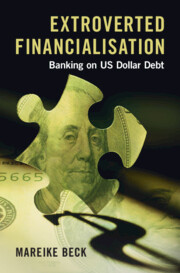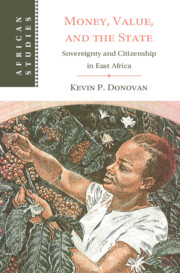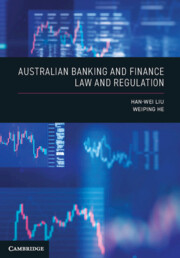Refine search
Actions for selected content:
96 results
The Nazi Financial Order: Banking Law and the Credit Supervisory Office in Germany and Austria
-
- Journal:
- Central European History , First View
- Published online by Cambridge University Press:
- 05 September 2025, pp. 1-27
-
- Article
-
- You have access
- Open access
- HTML
- Export citation
9 - Conclusion
-
- Book:
- Extroverted Financialisation
- Published online:
- 07 August 2025
- Print publication:
- 21 August 2025, pp 162-174
-
- Chapter
- Export citation
1 - Introduction
-
- Book:
- Extroverted Financialisation
- Published online:
- 07 August 2025
- Print publication:
- 21 August 2025, pp 1-23
-
- Chapter
- Export citation

Extroverted Financialisation
- Banking on US Dollar Debt
-
- Published online:
- 07 August 2025
- Print publication:
- 21 August 2025
Chapter 18 - Blame Game
- from Part III - Organizations and Actors of Contemporary Financial Infrastructures
-
-
- Book:
- The Cambridge Global Handbook of Financial Infrastructure
- Published online:
- 21 May 2025
- Print publication:
- 05 June 2025, pp 224-236
-
- Chapter
-
- You have access
- Open access
- HTML
- Export citation
Tunnelling when regulation is lax: the Colombian banking crisis of the 1980s
-
- Journal:
- Revista de Historia Economica - Journal of Iberian and Latin American Economic History / Volume 43 / Issue 1 / March 2025
- Published online by Cambridge University Press:
- 26 May 2025, pp. 79-106
- Print publication:
- March 2025
-
- Article
- Export citation
Introduction
-
- Book:
- Money, Value, and the State
- Published online:
- 05 December 2024
- Print publication:
- 12 December 2024, pp 1-50
-
- Chapter
- Export citation
2 - A Monopoly on Valuation
-
- Book:
- Money, Value, and the State
- Published online:
- 05 December 2024
- Print publication:
- 12 December 2024, pp 92-147
-
- Chapter
- Export citation
3 - Restricted Value
-
- Book:
- Money, Value, and the State
- Published online:
- 05 December 2024
- Print publication:
- 12 December 2024, pp 148-210
-
- Chapter
- Export citation

Money, Value, and the State
- Sovereignty and Citizenship in East Africa
-
- Published online:
- 05 December 2024
- Print publication:
- 12 December 2024
Chapter 29 - Sharīʿa, Sales and Loans in the Malaysian High Court
- from Part IV - Court Judgments and Other Court Documentation
-
-
- Book:
- Islamic Law in Context
- Published online:
- 14 November 2024
- Print publication:
- 21 November 2024, pp 311-320
-
- Chapter
- Export citation

Australian Banking and Finance Law and Regulation
-
- Published online:
- 14 November 2024
- Print publication:
- 17 October 2024
-
- Textbook
- Export citation
Chapter 5 - Banks, banking and the banker–customer relationship
-
- Book:
- Australian Banking and Finance Law and Regulation
- Published online:
- 14 November 2024
- Print publication:
- 17 October 2024, pp 148-166
-
- Chapter
- Export citation
Epilogue
-
- Book:
- Politics of the Past
- Published online:
- 05 April 2024
- Print publication:
- 11 April 2024, pp 237-252
-
- Chapter
- Export citation
7 - Basic Services
- from Part II - Essential Signs
-
- Book:
- Chinese Signs
- Published online:
- 29 February 2024
- Print publication:
- 07 March 2024, pp 55-66
-
- Chapter
- Export citation
5 - Money, Credit and Banking, 1000–1500
- from Section II - The Medieval Economy, 1000–1500
-
-
- Book:
- An Economic History of the Iberian Peninsula, 700–2000
- Published online:
- 22 February 2024
- Print publication:
- 29 February 2024, pp 130-157
-
- Chapter
- Export citation
8 - The Tokugawa Economy
- from PART II - Economy, Environment, and Technology
-
-
- Book:
- The New Cambridge History of Japan
- Published online:
- 15 January 2024
- Print publication:
- 23 November 2023, pp 267-295
-
- Chapter
- Export citation
2 - The Integration of Distributed Ledger Technology in Banking
- from Part I - Why Pay Attention to Distributed Ledger Technology in Banking?
-
-
- Book:
- The Role of Distributed Ledger Technology in Banking
- Published online:
- 26 October 2023
- Print publication:
- 09 November 2023, pp 35-68
-
- Chapter
- Export citation
12 - A Look into the Intermediaries of the Metaverse
- from Part V - A Further Look at DLT in Banking: Lessons Learned, Current Applications, and Future Scenarios
-
-
- Book:
- The Role of Distributed Ledger Technology in Banking
- Published online:
- 26 October 2023
- Print publication:
- 09 November 2023, pp 269-293
-
- Chapter
- Export citation
Capturing Regulation Under Imperial Rule: The Regulation of Palestine’s Banking Sector
-
- Journal:
- Enterprise & Society / Volume 25 / Issue 3 / September 2024
- Published online by Cambridge University Press:
- 08 August 2023, pp. 762-788
- Print publication:
- September 2024
-
- Article
-
- You have access
- Open access
- HTML
- Export citation
